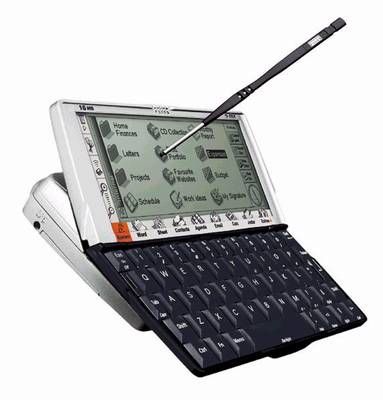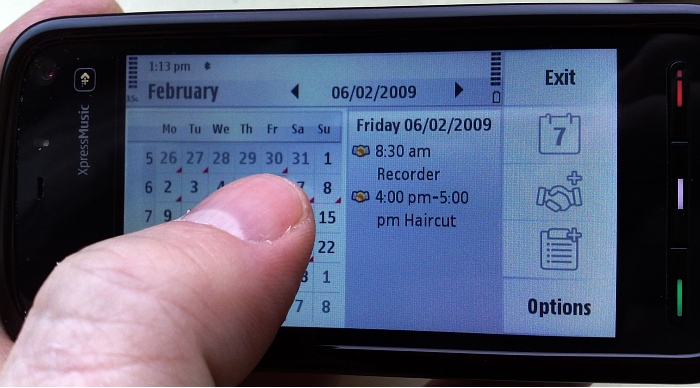|
 Now,
please don't write me off as a 'boring old fart'. OK, so I probably am
one, but that shouldn't discount my opinions - and I have used almost
every phone and PDA from the last 15 years, so my thoughts should count
for something. The subject under discussion here is Touch and my conclusion so far is 'Unconvinced'.... Now,
please don't write me off as a 'boring old fart'. OK, so I probably am
one, but that shouldn't discount my opinions - and I have used almost
every phone and PDA from the last 15 years, so my thoughts should count
for something. The subject under discussion here is Touch and my conclusion so far is 'Unconvinced'....
The first touch-based PDAs appeared in the mid 1990s, with Palm's
stylus-based PDAs, closely matched by Psion bringing in touch into
their EPOC-powered palmtops and then Windows Mobile (nee Pocket PC)
joining in the fun around the millennium. EPOC mainly evolved into
Symbian OS, running the S60 and UIQ interfaces, with the former
unashamedly button-driven and the latter unashamedly stylus-driven.
Despite the relative success of Palm's PDAs, I think it's fair to
say that the reliance on using a two-handed, stylus-driven interface
meant that none of these touch-screen devices really became totally
mainstream, in the sense that you'd see your mum or brother or
colleague using one with no encouragement from you.
And then the Apple iPhone
came along. Its main innovation was that it dispensed with the
conventional wisdom that touch meant a stylus and allowed the use of a
grubby, greasy, uneducated finger instead as its main driving force.
You still had to use two hands (most of the time) but at least one
barrier to use was removed for the main in the street.
A secondary innovation was the capacitive technology, meaning that a
touchscreen could, for the first time in years, actually be viewed in
sunlight and was incredibly responsive to the slightest touch. Backed
by a ground-up interface rethink and Apple's legendary 'cool', the
iPhone became a deserved (if rather high end) success.
With the result that most phone manufacturers have now jumped on the
'touch' bandwagon, trying to emulate the iPhone's success, or at least
its mojo. Even Nokia now has touch as one of its cornerstone interface
technologies for 2009, with the 5800 XpressMusic and N97 both sporting
the fully touch-enabled S60 5th Edition.
In an attempt to try and understand whether either will take off in
the real world, I had been using the 5800 as my main phone/device for
the last two weeks. But I've just put my main SIM back in the Nokia
N82, with the aforementioned 'unconvinced' as my verdict.

On the face of it, to get the latest and greatest version of S60,
plus an iPhone-like caressable interface on a lovely large screen, plus
a decent (if unspectacular) camera and some seriously loud speakers,
all in a body the same size as the N82, seemed a bargain and certainly
the sheer novelty factor kept me hooked for at least a week. However,
there are numerous problems, not all of which can be solved by firmware
updates:
- firstly and foremostly, touchscreen interfaces are superb when
you're unstressed and with both hands free. When you're on the move,
either in a car (with the device properly mounted on a stand, of
course) or walking down the street or on a bus or train, there's too much external vibration for accurate use.
You reach for an on-screen button but either don't reach the screen or
hit the wrong icon, ad infinitum. All the time wishing for a physical
d-pad or keypad that you can feel and manipulate even without looking,
if needed. Sorry, Nokia, Apple and so on, haptic feedback doesn't hold
a candle to physical control and character entry keys.
- the touch implementation on the 5800 XpressMusic (and presumably the upcoming N97) is flawed in that icons often don't respond to tapping and have to be tapped again - this should be fixed in firmware soon.
- text input using the on-screen keyboard is slow because of the use of a resistive touch-screen,
meaning that only one character can be tapped at a time: tap, release,
tap, release, and so on (c.f. the iPhone's multi-touch meaning that you
can go as fast as you like) - writing/spelling aids in a firmware
update might help alleviate speed concerns here - we'll see.
- the resistive screen is hard to see in strong light - it's as good as resistive gets but it's only marginally useable when using in direct sunlight.
- the resistive screen also requires significant pressure
- this is most noticeable and unpleasant when dragging web pages around
in Web. With Samsung adopting a capacitive screen for their S60
5th-powered Omnia HD, resistive touch technology is really looking
rather old fashioned now.
- finger-touch interfaces rarely take into account the way a
fingertip 'spreads' at the point of contact. In practice this means
that wrong icons, characters and options get selected, with time wasted as you back out of whatever you just went into by mistake.
- a full-screen touch device is necessarily more fragile. Not in a 'it might break' sense, necessarily, but in a 'have to treat it with extreme care'
way. Your kid wants to play a game on it - got to clean those greasy
hands first? Want to put it out on the pub table beside you, getting
showered with beer splashes and crisp crumbs? Want to just stick the
phone in a pocket? Must make sure the pocket is free from dust, dirt,
crumbs, keys and so on first. And if dirt does get on the screen, your
next page drag in Web might gouge the surface permanently. Resistive
touch screens have always
been this 'fragile' - witness the number of screen protection and
polishing kits available from the days of Psion and Palm onwards. The
strong glass display of the iPhone and other capacitive-screened
devices are better prepared for the onslaught of real life and much
easier to clear/protect.
A finger-touch interface is cool, is fun and, to a certain extent,
finger touch is novel. And yes, under ideal conditions, touch is faster
than a d-pad when there are lots of options available in a dialog or
menu or launcher page. And touch is arguably faster for entering text
when it's aid-assisted on a capacitive screen. But conditions aren't
usually ideal when using a phone day to day and for many operations a
traditional d-pad and physical keys (whether numeric or qwerty) are
faster and more satisfying.
Bruised and battered.... the almost indestructible, non-touch, key-driven N82
One of the 5800 and N97's big selling points is, of course, the
larger screen, and it's hard to fault having more display area. But I'd
argue that until some or all of the above problems are fixed or
addressed, the trade-off of the bigger screen just isn't worth it. I'm
currently using the almost indestructible and very tactile Nokia N82
but am eyeing up the N86 8MP as a possible replacement. For both of
these phones, 'touch' remains what happens when I pick the phone up to
'use' it and nothing more.
Steve Litchfield, All About Symbian , 24 Feb 2009
Bonus Link of Interest: An interesting article from IT Director, quoting research from reviews site reevoo,
in which 19,000 phone buyers were surveyed. 5 out of ten phones in the
bottom ten were 'touchscreen models'. In contrast, only 2 of the top
ten phones are 'touchscreen'. The top-rated phone with a score of 8.8
out of ten was the conventional-keypadded Nokia 5220 XpressMusic.
Apple's iPhone is (unsurprisingly) the highest scoring touchscreen
phone with a score of 8.3 out of ten.
A Reevoo.com spokesperson said:
"Manufacturers are keen to jump on the touchscreen bandwagon but most
of the current efforts are just not pushing the right buttons for
shoppers. We love the look of touchscreen phones, and the ability to
watch videos on a large screen, but touchscreen phones are hard to get
right and many shoppers are complaining that touchscreen interfaces are
just too fiddly."
Reviewers offered the following criticisms of current touchscreen phones:
"Touchscreen is a little hard to use if your fingers are not slender and pointy."
"The 'virtual' keyboards are rubbish, takes ages to type anything."
"I found the touchscreen hard
work and the physical 'pressing' was made more difficult by the fact
that your finger, however slim or fat, tends to 'spread' when you have
to press."
|